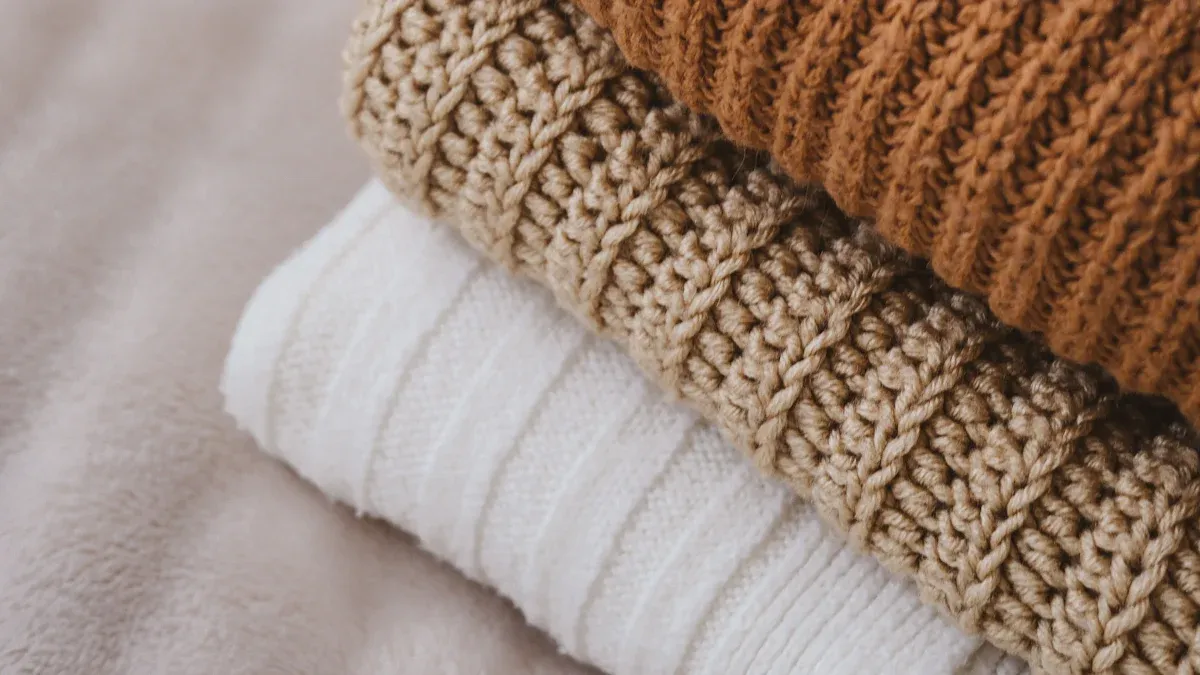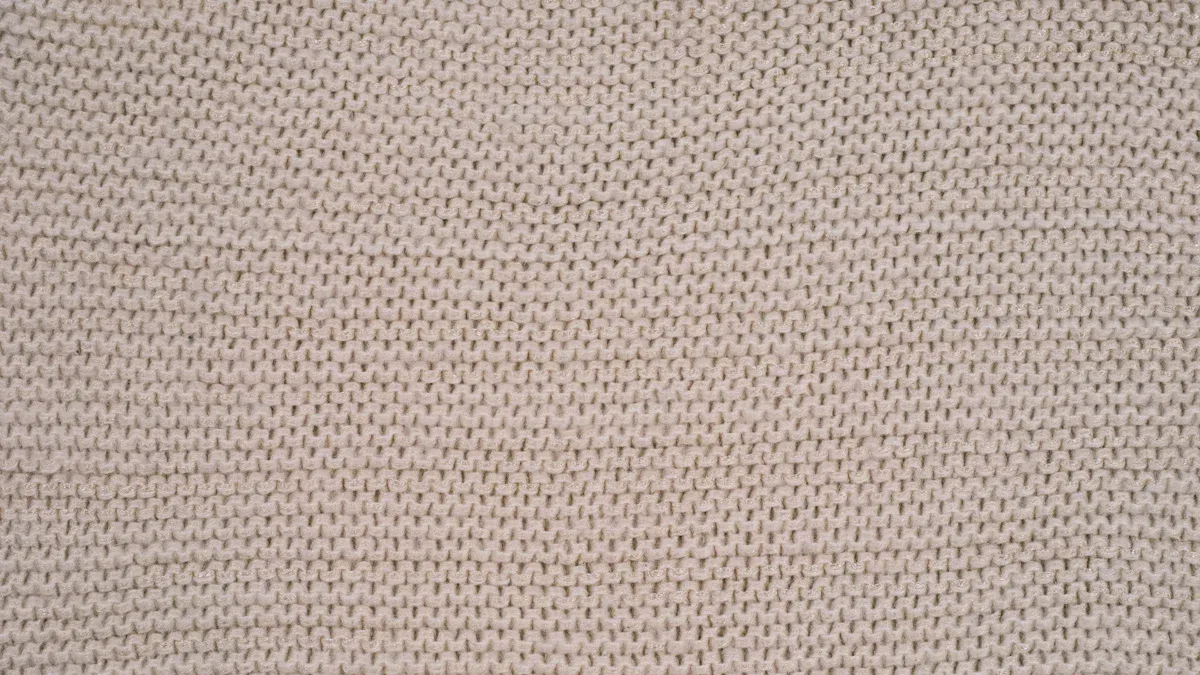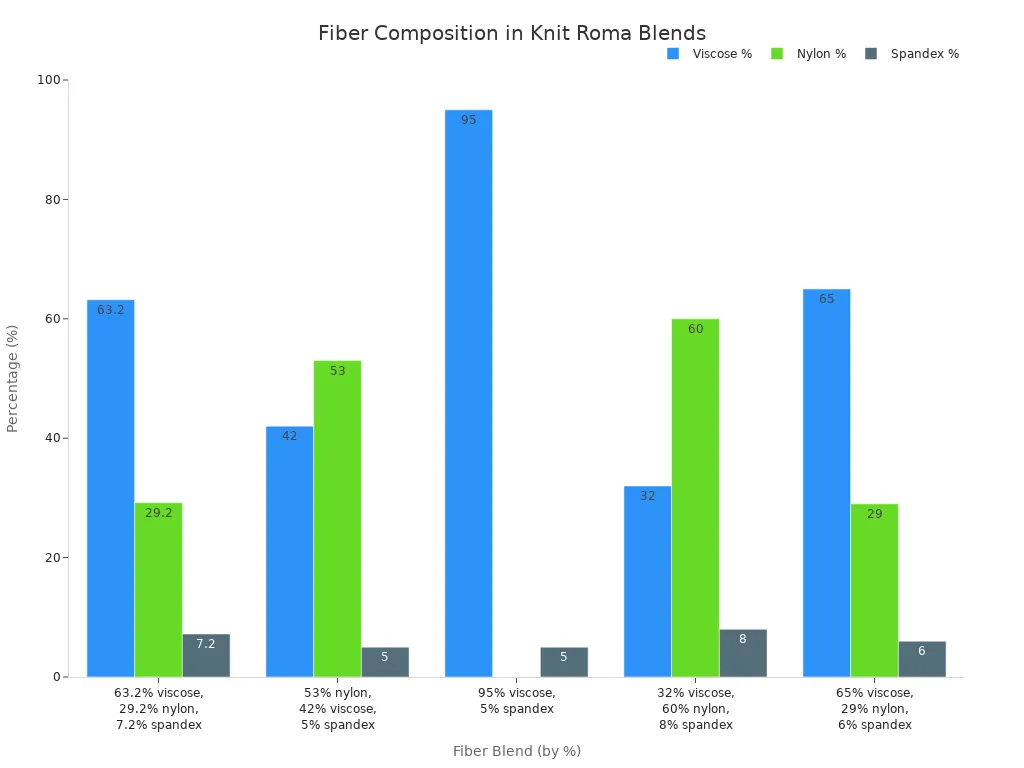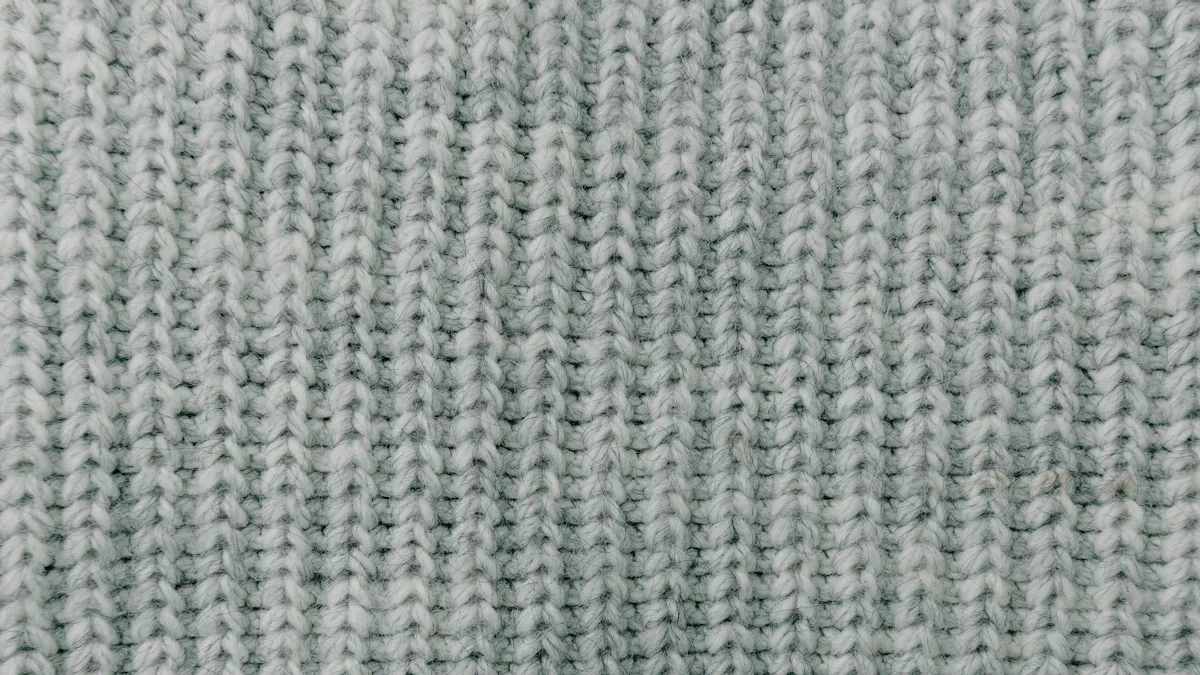
Knit Roma Fabric serves as a reliable option for apparel. It offers stretch, comfort, and structure, which make it ideal for dresses, pants, and blazers. Some users note it can feel heavy or warm. Designers, tailors, and anyone seeking polished, long-lasting garments benefit most from this fabric.
Key Takeaways
- Knit Roma Fabric offers excellent stretch, comfort, and shape retention, making it ideal for tailored dresses, pants, and jackets that need both structure and flexibility.
- The fabric resists wrinkles and holds its form well, reducing the need for ironing and ensuring garments look polished throughout the day.
- While Knit Roma Fabric provides durability and a smooth feel, it can feel heavy or warm in hot weather and may require gentle care to avoid pilling or shrinking.
Knit Roma Fabric: What You Need to Know

Key Features for Apparel
Knit Roma Fabric stands out for its unique blend of fibers and double-knit construction. Manufacturers often use a combination of viscose, nylon, and spandex to achieve a balance of stretch, durability, and comfort. The table below highlights common fiber compositions and weights:
| Composition (Fiber %) | Weight (GSM) | Description/Notes |
|---|---|---|
| 63.2% viscose, 29.2% nylon, 7.2% spandex | 210 | Common fiber blend combining viscose, nylon, and spandex for stretch and durability. |
| 53% nylon, 42% viscose, 5% spandex | 350 | Higher weight fabric with a similar fiber blend emphasizing nylon and viscose. |
| 95% viscose, 5% spandex | 250 | High viscose content with spandex for stretch, lighter weight. |
| 32% viscose, 60% nylon, 8% spandex | 240 | Nylon dominant blend with viscose and spandex for strength and flexibility. |
| 65% viscose, 29% nylon, 6% spandex | 220 | Balanced blend for durability, stretch, and comfort. |

The double-knitting technique creates a fabric with two smooth surfaces, offering firmness and stability. This structure prevents sagging and curling at the edges. The fabric’s weight and thickness provide a polished look and support for tailored garments. Key features include:
- Excellent stretch and recovery for comfort and flexibility
- Strong shape retention and wrinkle resistance
- Smooth texture for a professional appearance
- Versatility for both structured and casual garments
Common Uses in Clothing
Fashion designers frequently select Knit Roma Fabric for garments that require structure and comfort. The most common uses include:
- Dresses
- Skirts
- Pants
- Jackets
These items benefit from the fabric’s stability, drape, and wrinkle resistance. The heavier weight and double-knit construction make it ideal for both casual and formal wear, supporting a wide range of apparel needs.
Advantages of Knit Roma Fabric for Apparel
Stretch and Flexibility
Knit Roma Fabric offers impressive stretch and flexibility, making it a top choice for garments that require movement and comfort. The fabric’s double-knit construction, combined with spandex, allows it to stretch without losing its shape. Laboratory tests show that Knit Roma Fabric maintains high elastic recovery rates, even after repeated stretching. For example, at 10% strain, the elastic recovery rate reaches nearly 86%, and at 100% strain, it exceeds 93%. This means clothing made from this fabric can withstand daily wear and stretching without sagging or becoming misshapen.
| Property / Condition | Optimized Double-Wrapped Yarn/Fabric |
|---|---|
| Tensile Stress at 10% strain | 0.04 ± 0.0008 MPa |
| Tensile Stress at 30% strain | 0.09 ± 0.0005 MPa |
| Tensile Stress at 50% strain | 0.12 ± 0.002 MPa |
| Tensile Stress at 100% strain | 0.24 ± 0.004 MPa |
| Elastic Recovery Rate at 10% strain | 85.98% ± 0.62% |
| Elastic Recovery Rate at 50% strain | 91.51% ± 0.39% |
| Elastic Recovery Rate at 100% strain | 93.27% ± 0.18% |
| Elastic Recovery Rate after 5 cycles | 88.23% |

This level of flexibility supports a wide range of motion, making the fabric suitable for both fitted and relaxed garments.
Comfort and Softness
Many apparel makers choose Knit Roma Fabric for its soft, smooth texture. The blend of viscose and nylon creates a fabric that feels gentle against the skin. The double-knit structure adds a layer of cushioning, which enhances comfort during extended wear. People who wear garments made from this fabric often report a pleasant, cozy feel, even in structured pieces like blazers or pants.
Wrinkle Resistance
Wrinkle resistance stands out as a major benefit of Knit Roma Fabric. The fabric’s construction helps it maintain a crisp, polished appearance throughout the day. Unlike many woven fabrics, it resists creasing, even after hours of sitting or moving. This property makes it ideal for workwear, travel clothing, and any situation where a neat look is important.
Tip: Wrinkle resistance reduces the need for frequent ironing, saving time and effort in garment care.
Shape Retention and Durability
Knit Roma Fabric excels at holding its shape, even after repeated washing and wearing. The combination of nylon and spandex in the fiber blend gives the fabric resilience and strength. The fabric’s high elastic recovery rate ensures that it bounces back after stretching, which helps prevent bagging at the knees or elbows. This durability makes it a smart investment for staple wardrobe pieces.
Easy to Sew and Maintain
Sewing professionals find Knit Roma Fabric manageable, though it presents some unique challenges. Both sides of the fabric often look identical, making it tricky to mark the wrong side. The fabric’s smoothness can cause it to shift during sewing, especially when handling cuffs and facings. However, clear pattern instructions and video tutorials help guide the process. With careful handling and continuous sewing sessions, most experienced sewists achieve excellent results. Maintenance is straightforward, as the fabric’s wrinkle resistance and shape retention reduce the need for special care.
Versatility for Different Garments
Knit Roma Fabric adapts well to a variety of garment types and seasons. Its different weights support everything from lightweight summer tops to heavyweight winter sweaters. The table below shows how fabric weight influences garment suitability:
| Fabric Weight | GSM Range | Suitable Garments | Seasonal Use |
|---|---|---|---|
| Heavyweight | 200-250 | Sweaters, Sweatshirts, Hoodies | Winter |
| Mid-weight | 160-200 | Jackets, Coats, Sweaters | Cooler Temps |
| Lightweight | 100-150 | T-shirts, Tops, Pants, Skirts | Summer |
The fabric’s stretch, durability, and wrinkle resistance make it a reliable choice for both casual and formal wear. Designers use it for dresses, pants, jackets, and more, taking advantage of its ability to provide structure without sacrificing comfort.
Disadvantages of Knit Roma Fabric for Apparel
Can Feel Heavy or Warm
Some users report that garments made from Knit Roma Fabric can feel heavier than those made from lighter knits. The double-knit construction adds thickness and weight, which provides structure but also increases warmth. This characteristic benefits winter clothing but may cause discomfort in hot or humid climates. People who prefer lightweight, airy fabrics might find this material less suitable for summer wear.
Note: Heavier fabrics often provide a more tailored look but may restrict airflow and increase body heat retention.
Limited Breathability in Some Blends
Breathability varies depending on the fiber blend. High nylon or spandex content can reduce airflow, trapping heat and moisture against the skin. This limitation affects comfort, especially during physical activity or in warm environments. Some blends with higher viscose content offer better breathability, but overall, Knit Roma Fabric does not match the ventilation of lighter knits like cotton jersey.
| Blend Type | Breathability Level | Comfort in Warm Weather |
|---|---|---|
| High Nylon/Spandex | Low | Less Comfortable |
| High Viscose | Moderate | More Comfortable |
Prone to Pilling or Snagging
Knit Roma Fabric sometimes develops pills or snags, especially after repeated washing or friction. Pilling occurs when fibers break and form small balls on the surface. Snagging happens when sharp objects catch the fabric, pulling threads out of place. These issues affect the appearance and longevity of garments. Proper care and gentle washing can reduce the risk, but users should remain aware of this drawback.
Sizing and Fit Challenges
The stretch and recovery properties of Knit Roma Fabric create unique sizing challenges. The fabric stretches to fit the body, but improper pattern selection or construction may lead to garments that feel too tight or too loose. Inconsistent sizing between brands or patterns can confuse consumers. Accurate measurements and careful pattern adjustments help achieve the desired fit.
Tip: Always check garment measurements and consider making a test garment before cutting into expensive fabric.
Special Care Requirements
Although Knit Roma Fabric resists wrinkles and holds its shape, it sometimes requires special care. Some blends need gentle washing cycles or hand washing to prevent damage. High heat from dryers or irons can weaken fibers or cause shrinkage. Users should always follow care instructions on garment labels to maintain fabric quality.
- Wash with similar colors
- Use mild detergent
- Avoid high heat drying
- Lay flat to dry when possible
Knit Roma Fabric vs. Similar Fabrics

Comparison with Ponte Knit
Knit Roma Fabric and Ponte knit share similarities, but key differences set them apart for apparel makers. Both fabrics use double-knit construction, which gives them structure and stability. However, Ponte Roma typically features a poly-rayon-lycra blend. This blend creates a fabric that feels thicker and offers moderate stretch. Many sewists prefer Ponte Roma for its drape and durability. It resists curling, running, and pilling when cared for with gentle washing and line drying.
- Ponte Roma from popular retailers like JoAnn’s and Hancock’s receives praise for its long-lasting wear.
- Some Ponte knits, especially those made entirely from polyester, provide extra durability but may lack comfort.
- Stretch in Ponte Roma varies by blend and source, but it usually feels less stretchy than lighter double knits.
- Cost remains reasonable, with quality Ponte Roma averaging around $7.99 per yard.
- Higher-end options, such as Sophia knit, resist pilling better but cost more.
Knit Roma Fabric often offers more stretch and a softer hand, making it suitable for garments that require both comfort and structure. Swatching remains important, as exact properties depend on the specific blend.
Comparison with Jersey Knit
Jersey knit differs significantly from both Knit Roma Fabric and Ponte knit. Jersey knit uses a single-knit construction, resulting in a lighter, more breathable fabric. It drapes well and feels soft, making it ideal for t-shirts and casual wear. However, jersey knit lacks the firmness and shape retention found in double knits. It tends to curl at the edges and may stretch out over time. For structured garments like pants or blazers, Knit Roma Fabric provides better support and a more polished appearance.
When to Choose or Avoid Knit Roma Fabric
Best Uses in Apparel
Designers often select Knit Roma Fabric for garments that require both structure and comfort. This fabric works well for tailored dresses, pencil skirts, and fitted pants. Jackets and blazers benefit from its ability to hold shape and resist wrinkles. Many professionals recommend it for uniforms and workwear because it maintains a polished look throughout the day. The fabric’s stretch and recovery make it suitable for active office environments or travel clothing.
Tip: For beginners, this fabric offers a forgiving option when sewing structured garments. Its stability helps prevent stretching out of shape during construction.
A table below highlights ideal uses:
| Garment Type | Benefit Provided |
|---|---|
| Dresses | Smooth drape, structure |
| Pants | Shape retention |
| Blazers/Jackets | Wrinkle resistance |
| Skirts | Comfort, fit |
When It’s Not the Best Option
Knit Roma Fabric does not suit every project. Lightweight summer tops or garments for hot climates may feel too warm or heavy. Athleisure and sportswear often require higher breathability and moisture-wicking properties, which this fabric cannot provide. People with sensitive skin sometimes find the synthetic blends less comfortable. Delicate designs that need fluid drape, such as flowy blouses or scarves, work better with lighter knits like jersey.
Note: For garments exposed to frequent abrasion or rough surfaces, consider alternatives to reduce the risk of pilling or snagging.
Knit Roma Fabric provides structure, stretch, and durability for apparel. Some garments may feel heavy or warm. Designers should select this fabric for tailored pieces needing shape retention. For lightweight or highly breathable clothing, another material may suit better. Each project requires careful consideration of fabric properties.
FAQ
Is Knit Roma fabric suitable for beginners to sew?
Most beginners find Knit Roma fabric manageable. Its stability helps prevent stretching out of shape. Using sharp needles and careful pinning improves results.
How should someone wash garments made from Knit Roma fabric?
Wash Knit Roma garments in cold water with mild detergent. Lay flat to dry. Avoid high heat to prevent shrinkage and maintain fabric quality.
Does Knit Roma fabric shrink after washing?
Knit Roma fabric may shrink slightly after the first wash. Pre-washing the fabric before sewing helps prevent unexpected changes in garment size.
Post time: Jul-10-2025